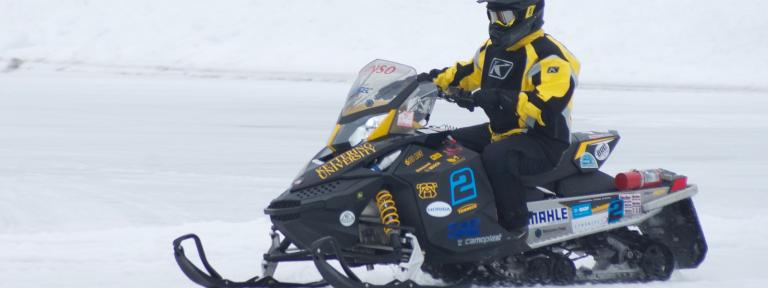
Kettering University's entry in the Clean Snowmobile Challenge 2001 in Jackson Hole, Wyo., produced significantly less unburned hydrocarbons, carbon monoxide and oxides of nitrogen (NOx) than an average automobile, according to comparison test results.
Organizers of the Society of Automotive Engineers (SAE) Clean Snowmobile Challenge compared the emissions of the Kettering snowmobile to the tailpipe emissions of an average automobile. The redesigned snowmobile proved to be far less polluting. Emissions tests run during the SAE collegiate design event revealed that a snowmobile designed by Kettering University produces lower unburned hydrocarbon (1.5 to 7 times less) carbon monoxide (1.5 to 7 times less), and oxides of nitrogen (and 5 to 23 times less) levels than the average automobile driven in Yellowstone National Park.
Kettering's team placed second overall in the competition, a close second place, trailing the first place team by only nine points out of a total 1500 points. As newcomers to the competition, Kettering won the $4,000 International Snowmobile Manufacturers Association Award for placing second, a $2,000 award from the Society of Automotive Engineers for best design and a $2,000 award for Quietest Snowmobile from representatives of the Montana Department of Environmental Quality, for a total of $8,000 in prize money.
The Kettering entry also boasted acceleration performance better than the late-model 500 cc two-stroke snowmobile used as a control snowmobile in the Clean Snowmobile testing.
"The Kettering University snowmobile is not only clean, it will set you back on your seat," said competition co-founder/organizer, Teton County Commissioner Bill Paddleford, who is an avid snowmobiler. "I would love to take this snowmobile out in the backcountry. It handles well and has lots of power."
Comparing snowmobile pollution to automobile pollution is a difficult task, due to differences between car and snowmobile emission test cycles. To help standardize their calculations, organizers used the same calculation methods and assumptions contained in the February 2000 National Park Service Air Quality Resources Division report titled, "Air Quality Concerns Related to Snowmobile Usage in National Parks." This report is generally accepted by environmental groups as the most comprehensive and credible assessment of Yellowstone's air pollution to date.
"Normally, we wouldn't take the time to make these comparisons because they have no bearing on our event," said environmental engineer and co-founder of the SAE Clean Snowmobile Challenge, Dr. Lori Fussell. "SAE is dedicated to providing engineering students with real-world problem solving experiences that will make them better engineers for the future. Our competition focuses on conducting high-quality research on methods to reduce snowmobile emissions and sound levels without sacrificing performance."
Just before the competition began, Dr. Fussell was asked by an environmental group concerned with winter use in Yellowstone National Park to use the competition results to make a direct comparison between cars and snowmobiles.
"When I saw the quality of the work the students had done, I decided to see how their data stacked up," she said.
It was not surprising to organizers that the snowmobile from Kettering University is cleaner than the average car. The snowmobile features a Daihatsu 659cc turbocharged 4-stroke engine. This engine is used in the Dahaitsu Mira, a mini-van that meets strict Japanese 2006 emission standards. An added bonus & the turbocharged engine is priced at just $600, including the turbocharger, catalyst and engine management system.
Designing a cleaner snowmobile is just one of the objectives of the SAE Clean Snowmobile Challenge. Noise abatement is also an important part of the competition. Highly sensitive audio equipment measured sound levels from this year's collegiate entries. Measurements were taken 50 feet from the road as the snowmobiles drove by at full throttle. The quietest snowmobile this year had a high reading of 67dBA. The ultra-clean Kettering University snowmobile hit a high measure of 72dBA on one of its passes. For perspective, the 2-stroke control (stock) snowmobile hit 78dBA, a level that is within legal limits in National Parks. The 67dBA reading represents an approximate 75 percent reduction in the noise level from that of the control snowmobile.
Dr. Fussell and Commissioner Paddleford teamed up to create the SAE Clean Snowmobile Challenge in the Fall of 1998. The two Teton County residents saw a need for improvements in noise and exhaust emissions from snowmobiles, but also recognized the importance of maintaining performance and keeping costs down. SAE Collegiate Design events are now held on six continents and host engineering students from over 150 universities worldwide.